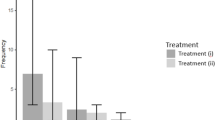Abstract
The compounds (Z,Z,Z)-3,6,9-nonadecatriene (I), (Z,Z,Z,E)-(II), and (Z,Z,Z,Z)-3,6,9,11-nonadecatetraene (III) have been implicated as components of the female sex pheromone of the fall cankerworm. Chromatographie determination of the proportions of these compounds in individual females of sympatric asexual and sexual reproductive forms of the species, with concurrent analysis of the electrophoretic profiles of the same females, showed that the I: II: III proportion of compounds was constant across electrophoretically differing asexual genotypes and between these and the sexual form. Life-history characters, in contrast, typically show great variation among these genetic groups. The results indicate that pheromonal constancy is maintained in a reproductive system that is theoretically vulnerable to selective pressures that would lead to heterogeneity in the species' pheromonal communication channel.
Similar content being viewed by others
References
Arn, H., Baltensweiler, W., Bues, R., Buser, H.R., Esbjerg, P., Guerin, P., Mani, E., Rausher, S., Szocs, G., andToth, M. 1982. Refining lepidopteran sex attractants. Les médiateurs chimiques agissant sur le comportement des insects.INRA Coll. 7:261–265.
Bailey, J.B., Mcdonough, L.M., andHoffman, M.P. 1986. Western avocado leafroller,Amorbia cuneana (Walsingham) (Lepidoptera: Tortricidae): Discovery of populations utilizing different ratios of sex pheromone components.J. Chem. Ecol. 12:1239–1245.
Cardé, R.T., Cardé, A.M., Hill, A.S., andRoelofs, W.L. 1977. Sex pheromone specificity as a reproductive isolating mechanism among the sibling speciesArchips argyrospilus andA. mortuanus and other sympatric tortricine moths (Lepidoptera:Tortricidae).J. Chem. Ecol. 3:71–84.
Cardé, R.T., andBaker, T.C. 1984. Sexual communication with pheromones, pp. 355–383,in W.J. Bell and R.T. Cardé (eds.). Chemical Ecology of Insects. Sinauer Associates, Sunderland, Massachusetts.
Collins, R.D., andCardé, R.T. 1985. Variation in and heritability of aspects of pheromone production in the pink bollworm moth,Pectinophora gossypiella (Lepidoptera: Gelechiidae).Ann. Entomol. Soc. Am. 78:229–234.
Fedde, V.H. 1974. Rearing the elm spanworm on artificial diet: A preliminary report. USDA For. Serv. Res. Note SE-204.
Futuyma, D.J., Leipertz, S.L., andMitter, C. 1981. Selective factors affecting clonal variation in the fall cankerwormAlsophila pometaria.Heredity 47:161–172.
Futuyma, D.J., Cort, R.P., andVan Nordwick, I. 1984. Adaptation to host plants in the fall cankerworm (Alsophila pometaria) and its bearing on the evolution of host affiliation in phytophagous insects.Am. Nat. 123:287–296.
Greenfield, M.D., andKarandinos, M.G. 1979. Resource partitioning of the sex communication channel in clearwing moths (Lepidoptera: Sesiidae) of Wisconsin.Ecol. Monogr. 49:403–426.
Harshman, L.G., andFutuyma, D.J. 1985a. The origin and distribution of clonal diversity inAlsophila pometaria (Lepidoptera: Geometridae).Evolution 39:315–324.
Harshman, L.G., andFutuyma, D.J. 1985b. Variation in population sex ratio and mating success of asexual lineagesof Alsophila pometaria (Lepidoptera: Geometridae).Ann. Entomol. Soc. Am. 78:456–458.
Haynes, K.F., Gaston, L.K., Pope, M.M., andBaker, T.C. 1984. Potential for evolution of resistance to pheromones.J. Chem. Ecol. 10:1551–1565.
Kiester, A.R., Nagylaki, T., andSchaffer, B. 1981. Population dynamics of species with gynogenetic sibling species.Theor. Pop. Biol. 19:358–369.
Klun, J.A., andCooperators. 1975. Insect sex pheromones: Intraspecific pheromonal variability ofOstrinia nubilalis in North America and Europe.Environ. Entomol. 4:891–894.
Klun, J.A., andMaini, S. 1979. Genetic basis of an insect chemical communication system: The European corn borer,Ostrinia nubilalis (Lepidoptera: Pyralidae) in New York.Environ. Entomol. 8:423–426.
Klun, J.A., Flimmer, J.R., Bierl-Leonhardt, B.A., Sparks, A.N., andChapman, O.L. 1979. Trace chemicals: The essence of sexual communication systems inHeliothis species.Science 204:1328–1330.
LÖfstedt, C., Lanne, B.S., Lofqvist, J., Appelgren, M., andBergstrom, G. 1985. Individual variation in the pheromone of the turnip moth,Agrotis segetum.J. Chem. Ecol. 11:1181–1196.
Miller, J.R., andRoelofs, W.L. 1980. Individual variation in sex pheromone component ratios in two populations of the redbanded leafroller moth,Argyrotaenia velutinana.Environ. Entomol. 9:359–363.
Mitter, C., andFutuyma, D.J. 1977. Parthenogenesis in the fall cankerworm,Alsophilapometana.Entomol. Exp. Appl. 21:192–198.
Mitter, C., Futuyma, D.J., Schneider, J.C., andHare, D. 1979. Genetic variation and host plant relations in a parthenogenetic moth. Evolution 33:777–790.
Mitter, C.,Neal, J.,Gott, K., andSilverfine, E. 1987.A geographic comparison of pseudogamous populations of the fall cankerworm (Alsophila pometaria).Entomol Exp. Appl. 43: In press.
Moore, G.E., andDrooz, A.T. 1974. Rearing the fall cankerworm on a natural diet. USDA For. Serv. Res. Note SE-197.
Moore, W., andMcKay, F.E. 1971. Coexistence in unisexual-bisexualPoeciliopsis (Pisces: Poecilidae).Ecology 52:778–790.
Porter, G.A., andAlden, C.H. 1924. The cankerworms.USDA Bull. 1238:1–37.
Roelofs, W.L., andBrown, R.L. 1982. Pheromones and evolutionary relationships of Tortricidae.Annu. Rev. Ecol. Syst. 13:395–422.
Roelofs, W.L., Hill, A.S., Linn, C.E., Meinwald, J., Jain, S.C., Herbert, HJ., andSmith, R.F. 1982. Sex pheromone of the winter moth, a geometrid with unusually low temperature precopulatory responses.Science 217:657–659.
Schneider, J.C. 1980. The role of parthenogenesis and female aptery in microgeographic ecological adaptation in the fall cankerworm,Alsophila pometaria Harris (Lepidoptera: Geometridae). Ecology 61:1082–1090.
Stenseth, N.C., Kirkendall, L., andMoran, N. 1985. On the evolution of pseudogamy.Evolution 39:294–307.
Struble, D.L., andByers, J.R. 1985. Identification of sex-pheromone components of the sibling speciesEuxoa ridingsiana (Grt.) andEuxoa maines (Sm.) (Lepidoptera: Noctuidae), and blends for their specific attraction.Can. Entomol. 117:495–504.
Templeton, A. 1981. Mechanisms of speciation—a population genetic approach.Annu. Rev. Ecol. Syst. 12:23–48.
West-Eberhard, MJ. 1984. Sexual selection, competitive communication and species-specific signals in insects.Symp. R. Entomol. Soc. London 12:283–324.
Wong, J.W., Palaniswamy, P., Underhill, E.W., Steck, W.F., andChisholm, M.D. 1984a. Novel sex pheromone components from the fall cankerworm moth,Alsophila pometaria.J. Chem. Ecol. 10:463–473.
Wong, J.W., Palaniswamy, P., Underhill, E.W., Steck, W.F., andChisholm, M.D. 1984b. Sex pheromone components of fall cankerworm moth,Alsophila pometaria. Synthesis and field trapping.J. Chem. Ecol. 10:1579–1596.
Wright, S. 1932. The roles of mutation, inbreeding, crossbreeding, and selection in evolution.Proc. Sixth Int. Congr. Genet. 1:356–366.
Author information
Authors and Affiliations
Rights and permissions
About this article
Cite this article
Mitter, C., Klun, J.A. Evidence of pheromonal constancy among sexual and asexual females in a population of fall cankerworm,Alsophila pometaria (Lepidoptera: Geometridae). J Chem Ecol 13, 1823–1831 (1987). https://doi.org/10.1007/BF01013231
Received:
Accepted:
Issue Date:
DOI: https://doi.org/10.1007/BF01013231




